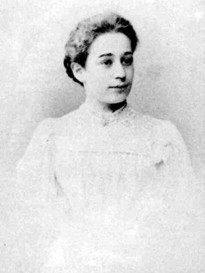Publicist, children’s and youth’s novelist, translator

Else Ury, a daughter of Emil Ury (1835-1920) and Franziska nee Schlesinger (1847-1940), was born on 1 November 1877 in Berlin [1]. She had two older brothers- Hans (1867-1937, a doctor) and Ludwig (1870-1963, a counsel), and sister Käthe (1875-1944) [2]. They have grown up in Berlin-Mitte district, near to Alexanderplatz, on Heilige-Geist-Straβe (then they lived on Kaiserdamm 24). Ury family has lived in Berlin since two generations, where Else’s grandfather- a merchant Levin Elias Ury- came to from Tangermünde (on the River Elbe, in Saxony) in 1828. It is known that he was a member of Jewish community council in Berlin. His son- Else’s father- graduated middle school and boned up on merchant craft. He became an owner of tobacco company (Tabakfirma Jacob Doussin & Co), produccing cigarettes since 1900. Else’s parents came from orthodox Jewish families. Acculturated to German culture, they were loyal citizens of Kaiserdom. They have raised their children liberally, religion was absolutely private thing. Every Friday they used to have a sabbath dinner, they would also celebrate other holidays and ceremonies together. Jewish identity and religious tradition played an important role in Else’s life only in childhood and school years. In her later books descriptions of Jews and their tradition rarely can be found [3].
Else was a student in urban school for girls- Królowa Luiza School (Königliche Louisen-Schule). There she was taught handiwork, drawing, singing, religion, French and English language, German language and literaturę, reckoning, geography and history, playing the piano and dancing as well. But there were no classes preparinf for a particular profession, girls were prepared for being wives and others instead. Elsa was never married though. In 1894 she graduated middle school and started so-called real courses preparing for matura exam. Having graduated high school, she started journalistic job, writing short stories for „Vossische Zeitung” newspaper. She wrote most of all for children and youths. Her first published book was a set of tales Was das Sonntagskind erlauchst (Berlin 1905). Altogether, she published almost 40 books (39 exactly). Most famous became series Nesthäkchen and Professors Zwilinge that came out in 1918-1925. In her works she was describing happy, familial, downright fulfilled life, promoting positive patterns and moral values, especially timeless character.
Thanks to Nesthäkchen’s series success and fee for other books, in 1926 Else Ury bought a house in Karpacz (Krummhübel, Dorfstraβe 191, now Konstytucja 3 Maja Street). She called it Haus Nesthäkchen (Dom Beniaminek). She had spend there plenty of time- both in summer and winter. When she was writing, she has a view at Schneekoppe- Śnieżka. Mountain landscape and nature in Karkonosze had an impression in her works, as well as legends and citizen’s cant. In June 1939 she visited Karpacz and her cherished house for the last time.
Else Ury’s career, as well as other Jews’ lives, was upset (and even broken) by Hitler’s access to political power and antisemitic laws. Her attitude towards national socialism was hard to uniquely determine, at least in 1939, when her committed book Jugend voraus was published. Most of all Ury felt she is German and she loved German culture. But on 6 March 1935 she was dealt out of Reich council of writers , prohibited to exercise a profession, moreover, her books appeared on List of Prohibited Books. By 1938 she has been translating her works into English. In 1937-1939 her tales’ translations into Swedish and Norwegian were published.
Because of her body of work, contribution for German literary culture, popularity among children, youths and their parents, Else Ury didn’t believe that living in Third Reich could be risky for her. She used to say: „Mir kann doch nichts geschehen…”- after all, nothing can happen to me [4]. In April 1938 she visited her nephew Klaus in London. However, she didn’t decide to emigarte because she had to take care of her elderly mother. They both had to live in so-called Judenhaus- house for Jews on Solinger Straβe 10. Her mother died in January 1940 and was buried at Jewish cementary Wissensee. Another days she had to spend in camp in northern Berlin (Sammellager). On 12 January 1943 she went to east (nr 638, transit 24) with other Jews from Berlin and probably the next day- 13 January- just from the ramp she went to gas chamber. In Museum Auschwitz-Birkenau’s collection Else Sara Ury’s suitcase is kept. [5]
Books that she left (as well as radio plays and adaptations), still command popularity nowadays [6]. In Karpacz, villa that was mentioned above villa is still standing. The bilingual board placed on its wall informs the tourists that since 1926 popular the writer has been its owner – German writer of Jewish roots. Jews deported from Berlin, including Else Ury, memorialize also special cobblestones. So-called Stoleperstein are on Savigna Square in Berlin, where writer’s brother- Hans Ury- has lived and served medical practice. It was also Else’s house. Thanks to Else’s nephew Klaus Heymann’s efforts at Weissensee cementary in Berlin on Else’s parents’ gravestone there is an inscription memorializing her etched: Else Ury, born in Berlin on 1 Noveber 1877, deported from Berlin on 12 January 1943, never came back [7].